D. Gorton shares his story of restoring a 1967 Avion C-10 truck camper and returning it to the American road. In 2014, the Avion has already traveled 7,000 miles.

We first met D. Gorton at the Texas Truck Camper Rally this past April. His truck camper, a 1967 Avion C-10, was the talk of the event. Folks were coming up to us saying, “Have you seen the Avion?” We had, but were waiting for an opportunity to introduce ourselves, and spend a few minutes inside this vintage aluminum beauty.
When we finally met D. Gorton and his wife, Jane, we hit it off immediately. It never ceases to amaze us on how truck campers attract such amazing people to our community. Their camper was equally impressive, and we knew we had to get the story behind their Avion restoration for Truck Camper Magazine.
What we didn’t know is that this very camper had been submerged in the Mississippi River two years after D and Jane found it. What had started as a restoration project became a rescue and a complete ground-up rebuild. This is D’s story of how the Avion was pulled from the flood waters, gutted, and bought back with its Avion spirit in tact.
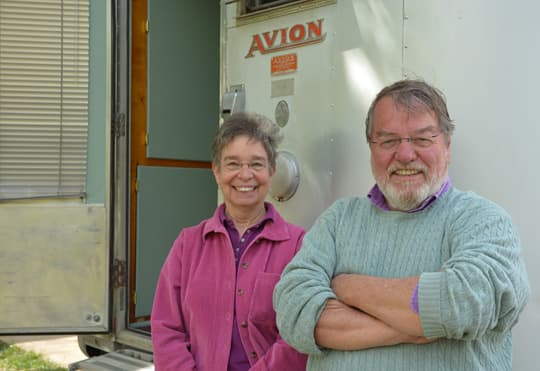
Above: Jane Adams and D Gorton with their 1967 Avion C-10
TCM: How did you come to restore a 1967 Avion C-10?
D: For as long as I can remember, I had a fantasy of having some sort of truck or van, kind of like a delivery truck with bunks. I thought about it as a kid. I finally got the chance later in life.
I wound up with an eight foot cabover-less Alaskan. That camper defeated me. I could not get anything right. From years of neglect, the camper had rot. The hydraulics were a challenge. I would call up the Alaskan factory and they would help me, but then I felt guilty for taking up so much of their time. It wasn’t working, so I put the Alaskan up for sale for a dollar. A guy came by and picked it up for a hunting camp.
Soon after, I found what I thought was the ultimate American camper, an Avion. I found one in Missouri, and brought it home. I thought it was in good shape. Unfortunately, I’m not the brightest bulb. It had problems, but I wasn’t experienced enough to know what they were.
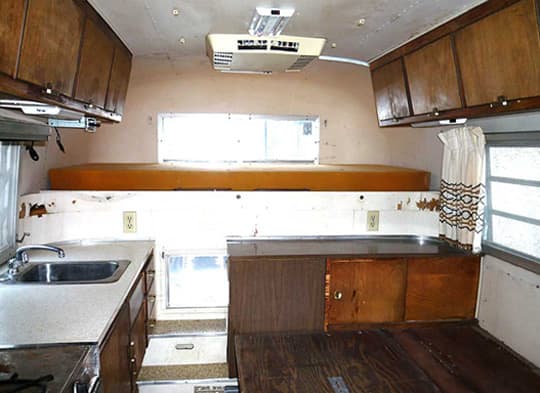
Above: Here is the interior of the coach when D and Jane first got it in 2008. Above is a fluorescent light and the roof mounted air-conditioning. On the right the bed is folded down and the cabinet containing the table is closed. An old car radio is suspended from the cabinets on the left. The camper had been in one family for many years and traveled twice to Alaska. Then it had been used in the last few years as a hunter’s shelter.
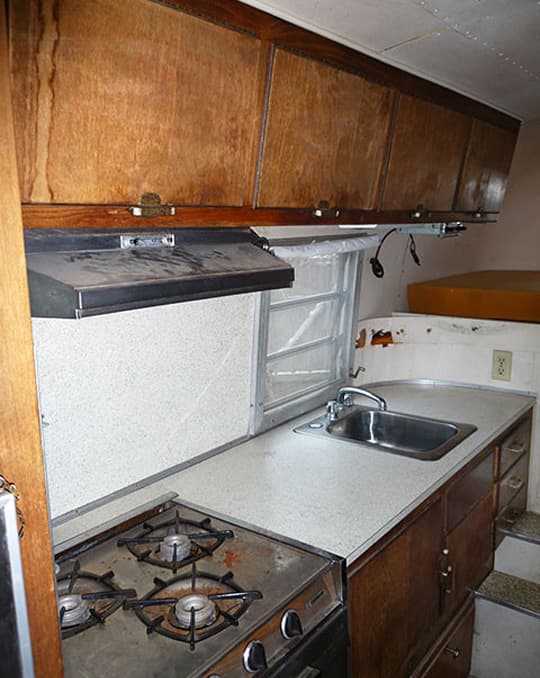
Above: Another photo from the beginning of the restoration. Note the stains in the woodwork, and the broken surround at the cabover.
TCM: How did you know what to do with a 1967 Avion?
D: I restore houses in Carbondale, Illinois, which is a college town. A lot of the neighborhood was built in the 1920s and 1930s. The houses have been run down through rentals, so I began buying properties and restoring them.
Through the restorations, I have learned a lot about electricity and plumbing. I took that knowledge and put it towards the Avion. The Avion was a project like one of our houses, just in the back of the truck. I knew I was dealing with an American original, something that was built during a great time in American history. These Avions were unique.
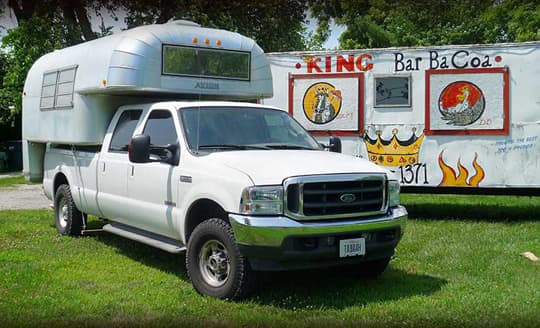
Above: The Avion before the restoration began. Note that the Avion logo is faded, but the exterior was in relatively good condition. This photo was taken in Olney, Illinois.
TCM: Did you have any help from family or friends during the project?
D: I engaged some of my workmen in the project. These are people who know about plumbing and electricity. When we had downtime from the house restorations, we would work on the Avion. It was a shared experience.
TCM: Did you aim to restore the Avion to original, or did you make changes?
D: About two years after owning the camper, it went into the Mississippi River. The river had overflowed in southern Illinois. People were putting sand bags down trying to protect the property during the flood. We went there to take them food and coffee and got too close. The rig went right in the water.
The camper had to be released separately from the truck, so it went under. The truck was undamaged, but everything was ruined in the camper. After that, I had to strip it and gut it. I kept everything in it that I could, but I had to start again.
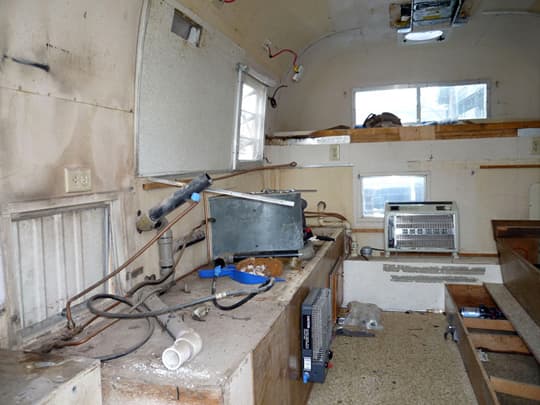
Above: Looking forward to the left side of the coach, everything is being removed. The Wave heater is still in its old position as is the air conditioner overhead.
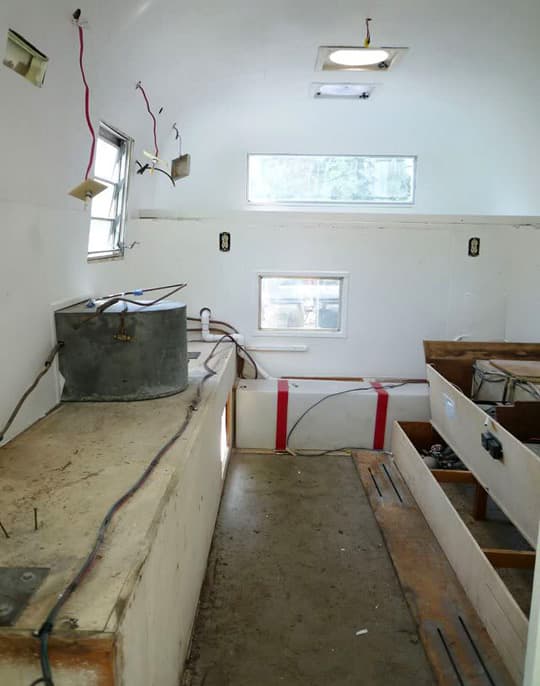
Above: Starting on the restoration after the coach had been pulled from the water. You can see the new 16 gallon water tank. The pump, gas detector and battery level indicators are all located on or under the footrest.
TCM: That’s terrible. How did you proceed after the flood?
D: I went back and rebuilt the camper. I did research online to find out how the camper was built, and restored it. I tried each step of the way to stay in line with the people who originally built the camper. I had conversations with the Cayo family, the family who founded Avion Coach. From those conversations, it was clear exactly what they were trying to do.
I use the same approach with the restoration of my houses. I make changes, but keep the meaning of the house. When I’m done with the house, it should feel like it did when it was brand new.
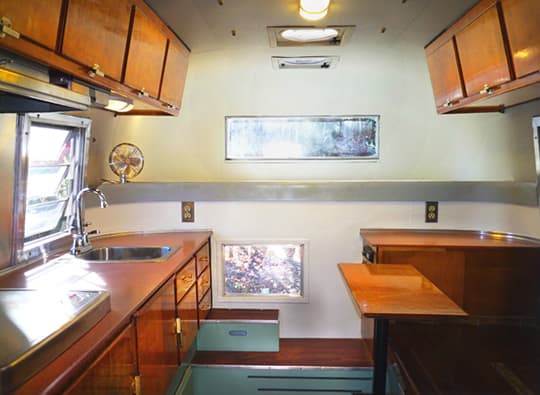
Above: Every water line and many electrical lines were replaced throughout the coach. All of the cabinets were removed and refinished. The OEM paint, Zolatone, was located and sprayed throughout the interior.
When I looked things up online, I found the interior OEM paint was a product called Zoletone. Zoletone is the same paint that’s used for Airstream interiors. It’s the same paint often used for the trunk of a car. If you drop something on it, it won’t scrape. You can wash it and it comes clean. It’s the perfect paint for the Avion.
I found a professional to paint it, but the Zoletone ruined his air hose three or four times. It’s really thick stuff with squiggle material in it, so it doesn’t go through an air hose very well. It was a burden for him, but it turned out to be a beautiful paint job.
From there I tackled the electric systems and wiring. I decided where I wanted things to go. I knew at that point I wanted to put wiring in for music and entertainment. I wanted cellphone and WIFI boosters. Because the camper was gutted and wide open, I could put things in easily.
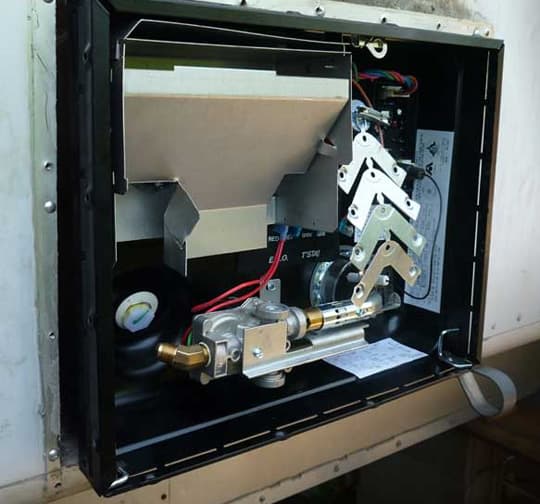
Above: The new hot water heater with the electronic starter. The six gallon Atwood slide directly into the slot that had contained the OEM Atwood heater from the 1960s.
It was the same for every other detail. We added a new water heater, which was made by the same company as the original water heater.
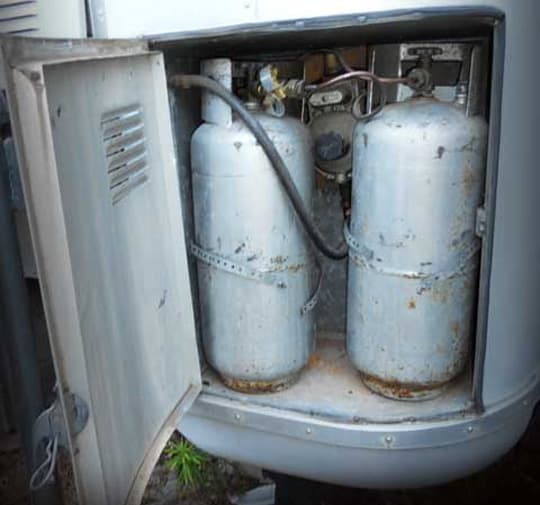
Above: The original dual bottle propane storage.
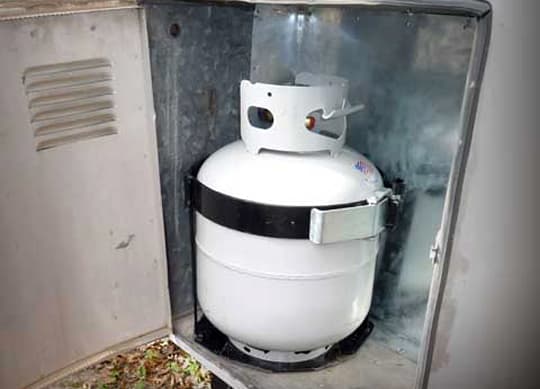
Above: Now a single bottle fits with a quick release that can also be used for outside cooking or heat. D also picked up cabinet space on the interior that helped with the grey water piping.
I also changed where the propane tanks went in. I was able to do more because the camper was wide open. In all, it took about a year and a half to restore the Avion after the submersion.
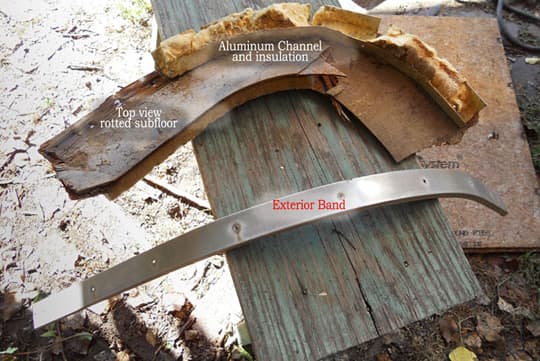
Above: These are the parts that were removed on the wings showing the OEM construction that D had to replicate.
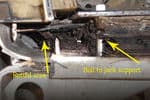 |
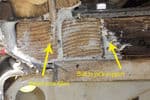 |
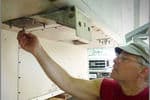 |
Above: Rot was discovered all along the curved bottom of the exterior among other areas including the floor, wings and cabover. They cleared out the rotten wood with augers and drove new treated wood into the area that was filled with epoxy. The jack supports were then reinstalled. Click to enlarge the photos above.
TCM: Was there anything on the Avion that needed to be replaced, but was hard to find or needed to be fabricated?
D: The original tie-down points were rotted out. We created the tie-down points that go under the wing of the camper. They actually go twice as far on the camper as I wanted to change the balance of the camper. This helped to prevent any torquing.
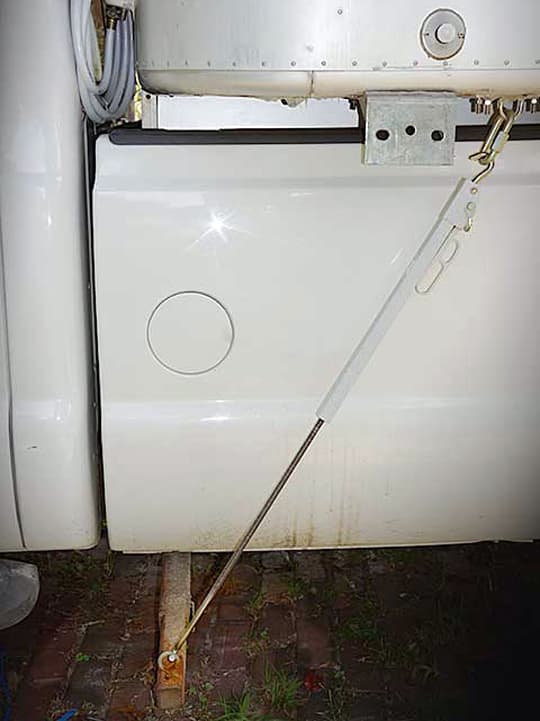
Above: THe Old School Belly bar connected to Torklift FastGuns.
We also took the entire cabover out because of wood rot. The interior wood rot was the most challenging problem we dealt with, by far.
TCM: Other than the unfortunate encounter with the Mississippi River, did you run into any unexpected challenges during the restoration?
D: I was open to anything being wrong. I didn’t think things would work well after forty-five years. There were going to be issues. Nothing was unexpected.
TCM: With what you know now, how might you approach an Avion restoration differently?
D: With what I know now, I could go through any Avion truck camper and know where the significant issues would emerge.
With a camper that old, you are going to have leaks and wood damage. More than likely with the Avions, the rot issues will be near the back door at the floor base and on the wings where the water goes down the overhang to the wing.
The Avion is built with a double hull on the exterior and interior with a separation of a half inch between the two. The interior has blown insulation material. The interior front nose wall of the camper and the interior back hull of the camper is fiberglass. With that type of construction, water travels everywhere. The camper is built like a thermos. Fortunately, the aluminum structure doesn’t go bad.
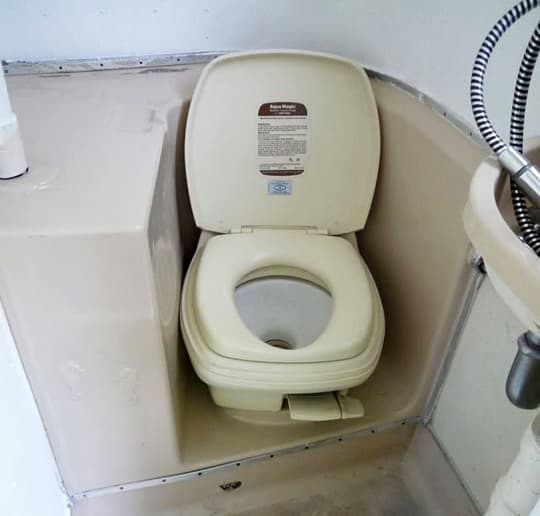
Above: The original toilet. It has been rebuilt using the OEM toilet.
The toilet and black tank were another issue. Under the toilet, we ran into more rot. That was one place where the original construction was sub-par. I’m surprised someone didn’t go crashing through the floor because it wasn’t very well put together.
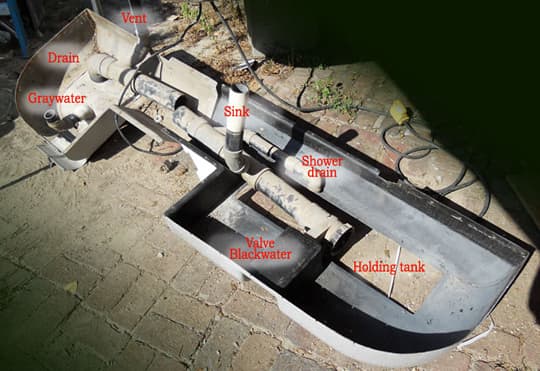
Above: The Avion was not built with grey water holding tanks and the black water tank was seriously damaged by water rot in the supports. This is the mock-up of the plumbing with all the old parts sitting on the bustle.
TCM: That would have been shocking, and dangerous. Does the Avion have fresh, grey, and black holding tanks?
D: Avions didn’t have grey tanks. They only had a black tank that was probably about eight to twelve gallons. We fabricated a grey tank that fits under the bustle of the camper. We took a PVC pipe and wrapped it back and forth a few times, and connected it to a drain. The capacity is about twelve gallons, and it works perfectly. The only downside is that the grey water doesn’t flush the sewer hose after dumping the black tank. I have to flush that out separately.
One of the biggest Avion discussions on the forums is about the toilet and holding tanks. It’s tough. We’ve had guys come up with all sorts of solutions, like stainless steel welded tanks. I would say two dozen people are actively restoring the Avion truck campers right now.
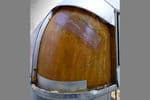 |
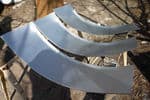 |
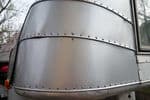 |
Above left: The smashed aluminum pieces on the right side have been removed revealing the molded fiberglass interior that forms the front of the cab over. The fiberglass and inserted insulation were repaired. Middle: Aluminum panels were ordered from Cayo in Watervliet, Michigan. Right: One rivet was missed and distorted the whole insulation. It had to be completely removed and re-riveted. Click to enlarge the above photos.
TCM: Did you need to do anything to restore the exterior aluminum?
D: I ran into an overhanging roof and popped out three panels and knocked out the fiberglass. Rebuilding that was one of the first challenges. None of us had ever done riveting, so we didn’t know what we were doing. On our first attempt, we got the wrong hole for the rivets so they didn’t fit quite right. On the third attempt, we got it right.
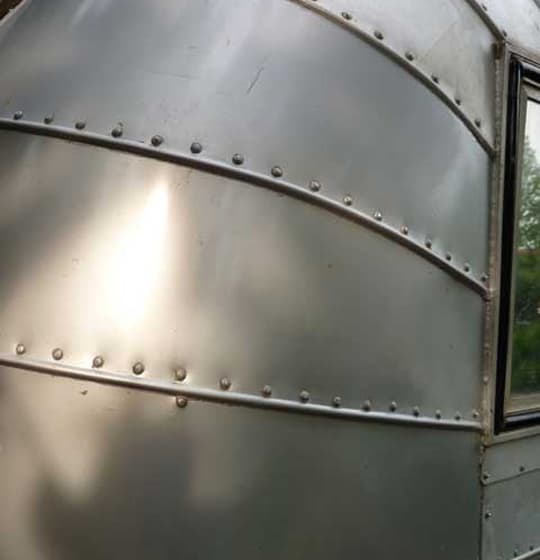
Above: This is after it was re-riveted, though the mistakenly punched hole is still there. The panel was wrapped correctly on the second try.
We had to repair the knocked out fiberglass. I had help for that and they did a really nice job. On the fiberglass interior, we put in regular batts of insulation material because we couldn’t do spray foam. That insulation is between the exterior aluminum and fiberglass.
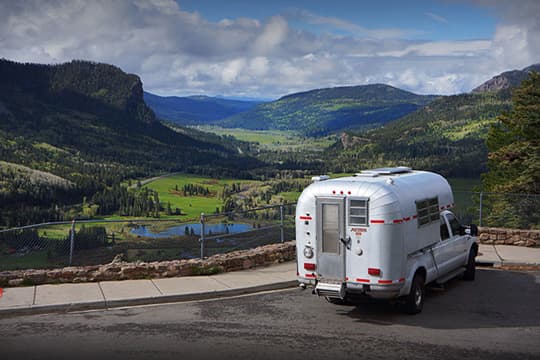
Above: The Avion at the dramatic overlook in Pagosa Springs, Colorado.
TCM: To be clear, the exterior haul of the Avion is aluminum, and the interior wall is fiberglass?
D: The exterior of the camper is anodized aluminum. The anodization gives the aluminum more resistance to corrosion. When the anodized aluminum is fresh, it looks terrific. No one has been able to figure out how to restore it to its original look. It seems to have stumped everybody.
The middle of the interior is also aluminum. The structure technology I presume is roughly the same as what the Airstreams had. A number of other campers also had riveted sheets of aluminum. In fact, due to the rot issues, there are guys rebuilding their Avions only using aluminum.
One of the only things that really surprised us, when we took off the panels, was finding places where the original manufacturer had missed screws going from the interior to the ribs. I have heard from fellow Avion owners about similar issues. The camper is created with aluminum ribs that go east-west and north-south. They are really suspended, and the frame makes it strong. The camper is tied together with the tub and wings. It’s the suspension that gives the camper structural strength.
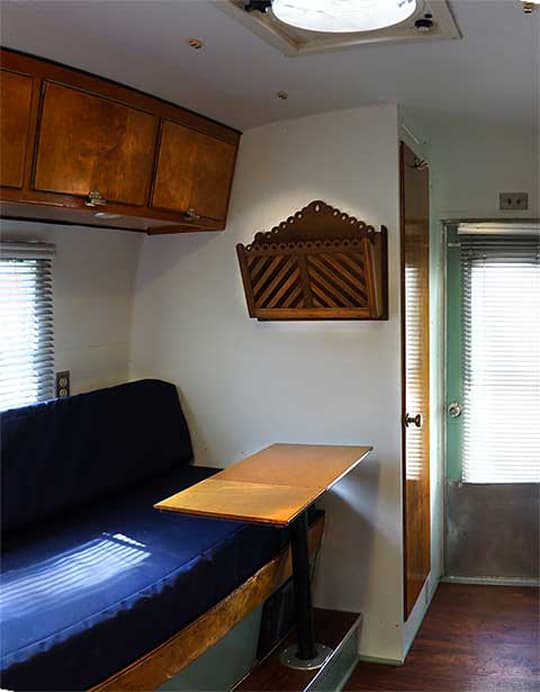
Above: Looking to the rear of the coach where the bathroom is enclosed on the left. A Fantastic fan is overhead and Allure waterproof floors are below. The couch/bed is covered in a blue marine cloth. On the wall is an antique magazine holder.
TCM: How long did it take to complete the Avion restoration?
D: It took a year and a half after the camper submerged, but I had already owned it for two years prior when I used it as it was. After the flood, I had to get rid of it or restore it. You’ve seen it and you know it’s a good machine, so you know why I had an interest.
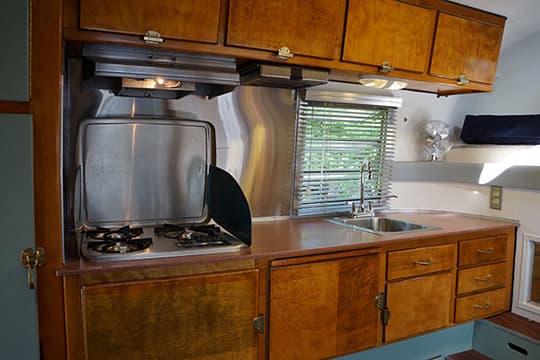
Above: The finished kitchen with stainless backsplash, drop in stove, LED lighting, and refinished cabinets.
TCM: Do you have an idea of the total cost of the project?
D: I would say in between $10,000 and $15,000, including parts and labor.
When I did the refurbishing of the wood work on the cabinets, it took a month. They had to be stripped completely. We had to get down to 220 grit to get the cabinets smooth. It took eight coats of varnish and we sanded in between each one of those coats.
I think that wood is birch. Fifty year birch tends to go dark and beautiful. When I sanded it down, it didn’t look like it does now. The moment I put the varnish on, you could see the beautiful color coming out.
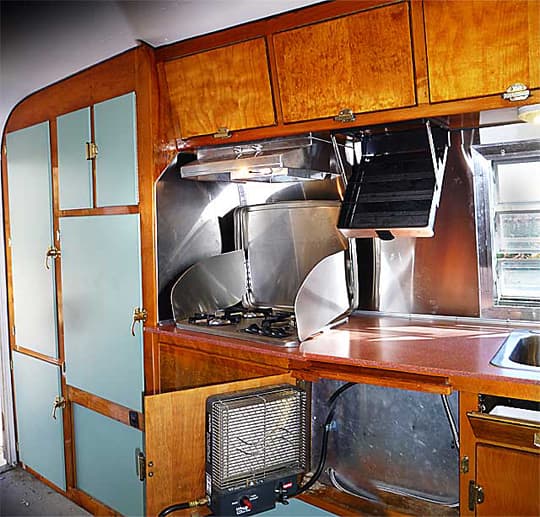
Above: The finished kitchen area and cabinets. There is a Corian counter top and a drop in three burner stove. The backsplash is stainless steel with the OEM vent. The aluminum windows were restored. A spice rack is opened from under the cabinets. A Wave catalytic heater is stored inside a cabinet behind a stainless cover over the new hot water heater. The latches overhead are original. The latches on the cabinets are “ice box” latches that remain securely shut even when the truck is going over rough ground.
We had lost some of the existing cabinetry, so I couldn’t match the original wood. I decided to paint all the large cabinets in aqua marine, a paint color used on boats. I understand color because I’m a photographer.
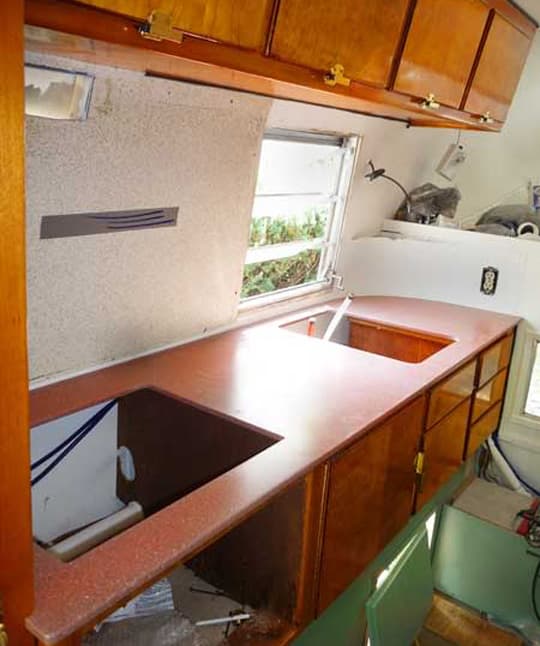
Above: Fitting the Corian countertop into the Avion.
I wanted my greens and browns, and the Corian countertops are in rose. The floor was made from Allure, which has a reddish quality. In photography we call this RGB, or red, green, and blue.
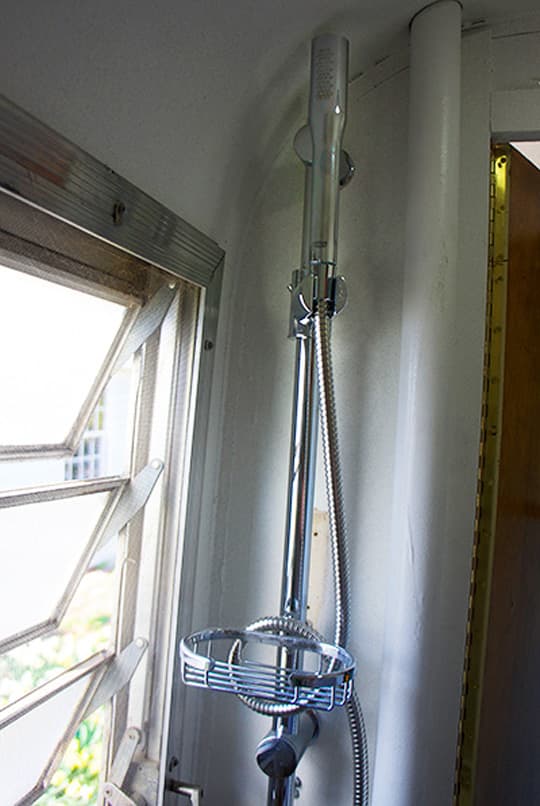
Above: A shower head with a slide, made in Germany, was placed in the bathroom.
TCM: How much of the Avion is still original?
D: About two-thirds is original. I added things like new shower handles and a cook top. It doesn’t look like an original Avion, but it’s got the feeling of being an Avion. They had linoleum floors and formica countertops, and I wasn’t about to do that. I think it’s attractive the way it is. My wife likes it too. That’s really important.
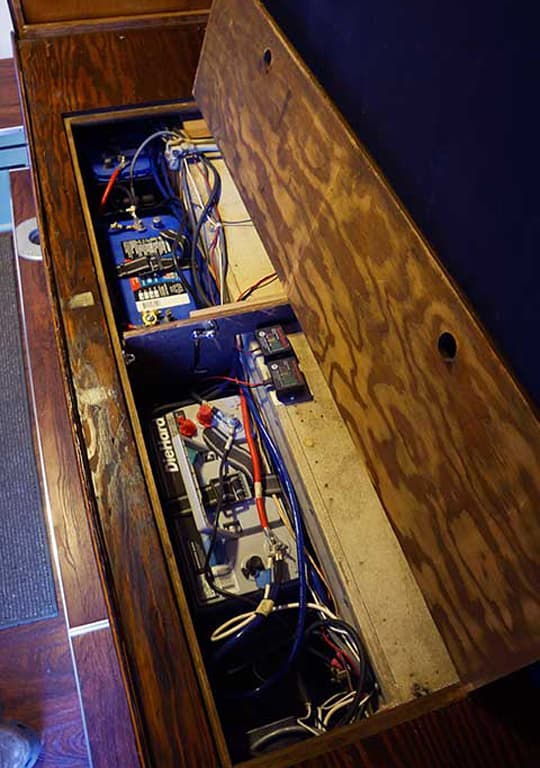
Above: The batteries are located under the seat of the coach. There is a three battery set up of group 31 AGMs. They are charged by a 200 watt solar panel, the truck’s alternator while driving, or shore power.
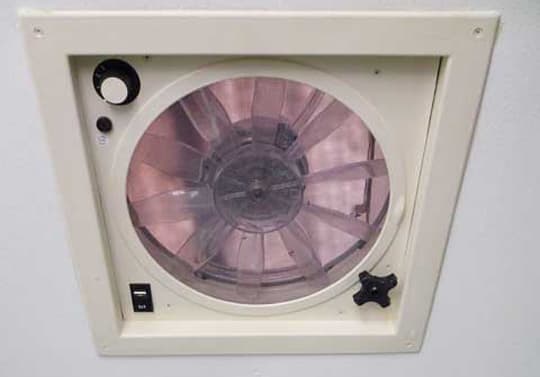
Above: D eliminated the air conditioner since they don’t camp in real hot weather, and they’re set up primarily for dry camping. Fantastic vent fans were added.
TCM: Yes, it is.
D: We’ve got issues now with the bed. The slide-out bed doesn’t work well. I also took the air conditioner off, and put in vents in the ceiling. Two of the vents are wired with Fantastic Vent fans. On the roof I added a 200 watt solar panel that charges the batteries, and we have three group 31 AGMS, which is overkill.
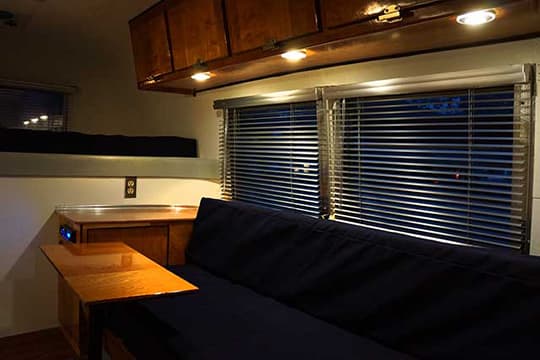
Above: At night, the cabin is lit with LEDs including marine puck lights. On the window are stainless steel shades.
I also went through and changed every light to LED. The fans use micro motors which draw little power. I think I could stay on the road boondocking for at least a week. With the 200 watt solar panel, three AGM batteries, and LED lights, we are not going to run out of power. If anything, I would run out of holding tank capacity.
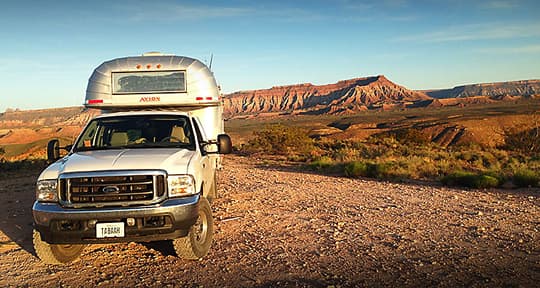
Above: Boondocking overlooking the Virgin River in Utah.
One of the discoveries is with the rounded corners is that the camper slips through the air while we drive. It’s different than the flat top campers. The Avion is aerodynamic, so I don’t have problems with big trucks.
I also want to point out the power of the internet. I have been able to find everything I need at my local Kamper Supply store, eBay, or other websites. Without the internet I couldn’t find all the parts that I’ve needed. It’s empowered all of us who have these older machines to restore them, and to do a pretty good job at it.
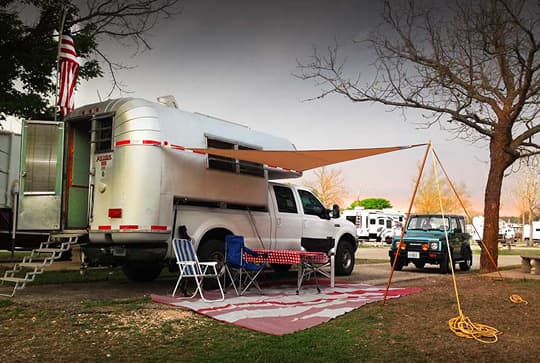
Above: Camping at the Texas Truck Camper Rally, Kerrville, Texas
TCM: Is there anything else you’re hoping to do to the camper at this point?
D: My Avion is basically done. As you know, we use it. We’ve traveled a lot this Spring. We went from Illinois to the Texas Truck Camper Rally where we met you both. Then we traveled to Virginia for the Mid-Atlantic Truck Camper Rally. From there we went to Flagstaff for the Overland Expo. This Fall we are going to the Bitterroots in Montana and Idaho. There are lots of things we want to do and we are able to do it with this camper.
We own rental properties here in Carbondale and I’ve always got issues with tenants, but I can take care of most things through texting, email, and phone calls. I can tell the workmen where to go, and what needs attention. The truck camper has allowed us to enjoy being on the road. We don’t have to be worried about leaving stuff undone.
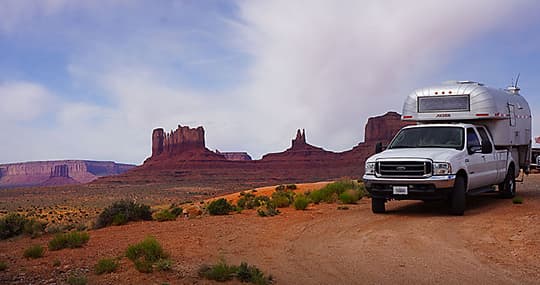
Above: The Avion near Moument Valley, Utah. You can see the antenna for the WIFI and cell phone booster. They installed multiple devices to enhance their digital devices while on the road so that D and Jane can keep in touch with their businesses and Jane’s responsibilities on City Council where she is an elected official and
Mayor Pro Tem.
When the Avion was built in 1967, people used to make phone calls collect. But now, in 2014, we have everything onboard for communication like our iPhone, iPad, cell boosters, and WIFI, so we can always in stay in touch, unless we don’t want to. It’s all there. It’s incredible, a wonderful thing we’ve got.
In many ways we have created a time capsule, a machine that spans decades of American history and innovation. It has all of the creature comforts and convenience of the present, along with the beautiful workmanship of the past. I heard someone say it reminded them of Buckaroo Banzai across the 8th Dimension.
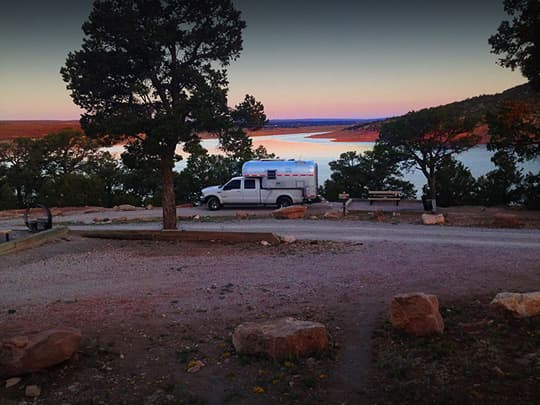
Above: Traveling on backroads, avoiding the freeway, they luck on some interesting places. Camping at Bluewater Lake State Park, high in the New Mexico mountains. D took this image at dawn.
TCM: What are your truck camping plans in the future? How about Alaska or the California coast?
D: We’ll do all of it. My wife is an elected official and has to attend city council meetings every three weeks. She missed one when we were in Arizona but, other than that, we can’t be out for more than sixteen to eighteen days at a time, and then we have to be back here. If she gets off the council, then we’ll head places like Alaska. I’d really like to go to Mexico. I used to go to Mexico back in the day. Now people are terrified of Mexico, and that presents a challenge. I want to go do it.
TCM: We have some fantastic articles about truck camping in Alaska and Mexico in our Off-Road and Expeditions section from folks who have been there, and share their advice. We want to go too, except there’s this magazine we have to run. Some day.
Changing the subject, you were a Photojournalist with the New York Times and then a freelance professional photographer for rock stars, movies, and national magazines. Now that you’re shooting primarily for yourself, is photography still fun?
D: Photography is more fun now because, for so many years, I worked so much. Work and fun don’t always go together, and it was hard work at times. Now I just point and shoot and enjoy photography to no end. It’s great, but it’s not as significant as what I used to do.
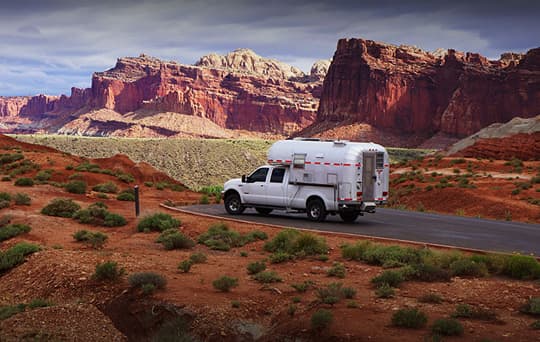
Above: D had visited Capitol Reef many years ago, and it left a lasting impression on him. But he wasn’t prepared for the unending, almost impossible beauty of the area when they visited in May of 2014.
TCM: Any tips for the many avid amateur photographers who read TCM?
D: I don’t know as much about digital photography as I did film photography. As they say, it takes 10,000 hours to perfect something you do. With film and chemistry I did 10,000 hours. I looked at something and knew exactly what the print was going to look like. I can’t say the same thing about digital photography.
When I make a digital image and go to Photoshop, I use a lot of the same techniques that I did for film and chemistry. I make the edges darker, which is a technique I used with black and white or color. It brings your attention to the center. I also crop and use various controls to lighten or darken the image. I don’t do much more than that.
My advice is to watch for backlight. Don’t shoot into the sun unless you know what you’re doing. I’m sure fellow truck campers know about the magic hour; the hour as the sun is coming up, and when the sun is going down. That’s when you can get long shadows and good colors in the sky. Filters can bring the sky tone down a bit. The ratio of light to dark is tighter with a digital photographer. You have more contrast, and it tends to blow out.
I use a Sony NEX-series camera and Leica and Nikon lenses with an adaptor. I have 400mm lenses to hook on to my camera.
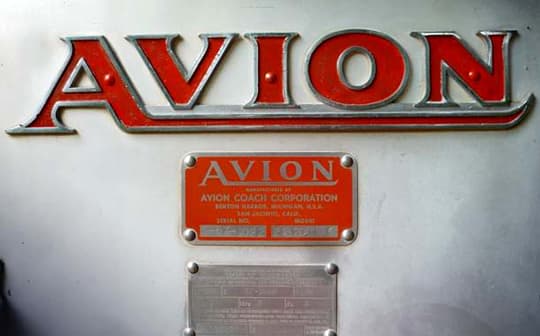
Above: Badge on the back of Avion truck camper showing that it was built in 1967 in San Jacinto, California.
TCM: Is there anything else about your Avion or truck camping lifestyle that you would like to share?
D: I think our lifestyle is relatively nomadic. We don’t settle down very long. We tend to move at least every other day, if not every day. That’s what we do. We also enjoy showing people the Avion.
We have as much fun driving as camping. If we want some coffee, we pull the truck over and it’s all there. It’s extraordinary convenient.
I don’t understand why more people don’t get out there in truck campers, like you guys do and we do. It’s a blast. I wish I could tell the world. There’s something there. You’re not going to believe how much enjoyment you get from the experience.
Truck: 2004 Ford F350, crew cab, diesel, 4×4, long bed, single rear wheel
Camper: 1967 Avion C-10
Tie-Downs: Torklift Fastguns
Jacks: Rieco-Titan tripod jacks, mechanical, taken off and left at home
Suspension: Airbags
Gear: Back-Up Camera
